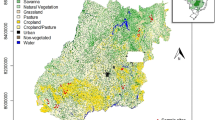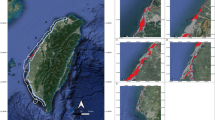Abstract
Lake Tana is the largest lake in Ethiopia, and it is the origin of the Blue Nile River (Abay). It harbors winter birds and globally threatened bird species. The wetlands in the area are nesting places of Wattled and Black Crowned Cranes. The wetlands are being converted into different land uses; however, how much area of these wetlands is being converted into different land uses is not known yet. This study therefore investigated the land-use change of the main nesting place of cranes in Chimba and Yiganda wetlands, in the Lake Tana Biosphere Reserve area. The land-use cover change was estimated by analyzing satellite images (Landsat images-ETM + from USGS website) from 1986 to 2016. The result showed that in 1986, the Chimba wetland area covered a total of 15,134,974.6 m2, which is 7.4% of the total area of Chimba watershed (203,312,456.3 m2). Other land use land cover types in the study area namely cultivated land covered 31.9%; farm village 2.1%, natural forest 41.3% and grass land 17.3%. However, the land-use land cover change (LULC) in 2016 showed that the wetland coverage declined to 10,708,894 m2. About 27.6% of the wetland is converted completely into cultivated land. Yiganda watershed covered about 28,075,506 m2 in 1986 of which 5,351,641.7 m2 was wetland area; however, the wetland area has shrunk to 4,668,162.9 m2. When it is compared to the wetland change in 1986 to 2016, Chimba wetland was more affected in which 663.5 ha was changed into another land-use land cover; whereas in Yiganda it was about 137.2 ha changed during the last 30 years. When the exponential trend change of LULC is observed, it could affect crane ecology by reducing the habitat availability for cranes nesting spaces.
Access this article
We’re sorry, something doesn't seem to be working properly.
Please try refreshing the page. If that doesn't work, please contact support so we can address the problem.







Similar content being viewed by others
References
Abebe WB, Minale AS (2017) Land use and watershed management practices in Lake Tana Basin. In: Stave K, Goshu G, Aynalem S (eds) Social and ecological system dynamics: characteristics, trends, and integration in the Lake Tana Basin, Ethiopia. Springer, New York, pp 472–521
Aynalem S (2017) Birds of Lake Tana Sub-Basin. In: Stave K, Goshu G, Aynalem S (eds) Social and ecological system dynamics: characteristics, trends, and integration in the Lake Tana Basin, Ethiopia. Springer, New York, pp 179–206
Aynalem S, Bekele A (2008) Species composition, relative abundance and distribution of bird fauna of riverine and wetland habitats of Infranz and Yiganda at southern tip of Lake Tana, Ethiopia. Trop Ecol 49(2):199–209
Aynalem S, Bekele A, Getahun A (2008) Species diversity, distribution, relative abundance and habitat association of the avian fauna of modified habitat of Bahir Dar and Debre Mariam Island, Lake Tana, Ethiopia. Int J Ecol Environ Sci 34:259–267
Aynalem S, Nowald G, Schroder W (2011) Observation on the biology and ecology of cranes: Wattled Cranes (Bugeranus carunculatus), Black Crowned Cranes (Balearica pavonina), and Eurasian Cranes (Grus grus) at Lake Tana Ethiopia. INDWA 7:1–12
Aynalem S, Goshu G, Wondie A (2017) Wetlands of the Lake Tana watershed. In: Stave K, Goshu G, Aynalem S (eds) Social and ecological system dynamics: characteristics, trends, and integration in the Lake Tana Basin Ethiopia. Springer, New York, pp 245–256
Aynalem S, Nowald G, Schroder W (2018) Black Crowned, Eurasian, and Wattled Cranes and agricultural expansion at Lake Tana, Ethiopia. In: Austin JE, Morrison KL, Harris JT (eds) Cranes and agriculture: a global guide for sharing the landscape. International Crane Foundation, Wisconsin, pp 191–195
Beilfuss R (2000) Piecing together the story of an African floodplain: water, wetlands, and Wattled Cranes. ICF Bugle 26:1–3
Beilfuss R, Dodman T, Urban E (2007) The status of cranes in Africa in 2005. Ostrich 78:175–184
Brown JL (1969) Territorial behavior and population regulation in birds: a review and re-evaluation. Wilson Bull 81:293–329
Burger J, Gochfeld M (1990) Nest site Selection in Least Terns (Sterna antillarum) in New Jersey and New York, Colon. Waterbirds 13:31–40
Clark RG, Shutler D (1999) Avian habitat selection: pattern from process in nest-site use by ducks? Ecology 80:272–287
Douthwaite RJ (1974) An endangered population of Wattled Cranes. Biol Cons 6:134–142
Dudgeon D, Arthington AH, Gessner MO, Kawabata ZI, Knowler DJ, Lévêque C, Naiman RJ, Prieur-Richard AH, Soto D, Stiassny ML, Sullivan CA (2006) Freshwater biodiversity: importance, threats, status and conservation challenges. Biol Rev 81(2):163–182
FDRE (2014) Application for nomination of ‘Lake Tana Biosphere Reserve’; The Nature and Biodiversity Conservation Union (NABU) in cooperation with Michael Succow Foundation, Addis Ababa, Ethiopia
Goshu G, Aynalem S (2017) Problem overview of the Lake Tana Basin. In: Stave K, Goshu G, Aynalem S (eds) Social and ecological system dynamics: characteristics, trends, and integration in the Lake Tana Basin Ethiopia. Springer, New York, pp 9–23
Johnsgard PA (1983) Cranes of the World. Indiana University Press, Bloomington, p 316
Jones KL (2003) Genetic variation and structure in cranes: a comparison among species. Ph.D. Thesis, University of Illinois, Chicago.
Kalmbach E (2017) Establishment of the Lake Tana Biosphere Reserve within the UNESCO World Network of Biosphere Reserves. In: Stave K, Goshu G, Aynalem S (eds) Social and ecological system dynamics: characteristics, trends, and integration in the Lake Tana Basin Ethiopia. Springer, New York, pp 523–544
Konrad PM (1981) Status and ecology of Wattled Crane in Africa. In: Lewis JC, Masatomi H (eds) Crane Research around the World. Proceedings of the international crane symposium at Sapporo: international council for bird preservation, Sapporo. pp 220–237
LaBonte JR, Scott DW, McIver JD, Hayes JL (2001) Threatened, endangered and sensitive insects in Eastern Oregon and Washington forests and adjacent lands. Northwest Sci 75:185–198
Meine CD, Archibald G (1996) The Cranes: Status Survey and Conservation Action Plan. IUCN, Gland
Minale AS, Abebe WB (2017) Land-use distribution and change in Lake Tana Sub Basin. In: Stave K, Goshu G, Aynalem S (eds) Social and ecological system dynamics: characteristics, trends, and integration in the Lake Tana Basin Ethiopia. Springer, New York, pp 357–374
Mukherjee A, Soniya VC, Borad CK, Parasharya BM (2000) Nest and eggs of Sarus Crane (Grus antigone antigone Linn.). Zoos’ Print J 15:375–385
Nesbitt SA (1989) The significance of mate loss in Florida Sandhill Cranes. Wilson Bull 101:648–651
Nowald G, Schröder W, Wilhelmi F (2007) First Survey of Eurasian Cranes (Grus grus) in Ethiopia. Report by Crane Conservation Germany Crane Information Center GroßMohrdorf, Mohrdorf
Tilahun S, Edwards S, Tewolde-Berhan GE (eds) (1996) Important bird areas of Ethiopia: a first inventory. Ethiopian Wildlife and Natural History Society, Semayata Press, Addis Ababa
UNESCO (2014) Lake Tana Biosphere Reserve, Ethiopia: https://en.unesco.org/biosphere/africa/lake-tanaon 04 February 2020.
Vinson MR, Hawkins CP (1998) Biodiversity of stream insects: variation at local, basin, and regional scales. Annu Rev Entomol 43(1):271–293
Walkinshaw LH (1973) Cranes of the world. Winchester Press, New York
Winter, S. (1991) The Demoiselle Crane in the agricultural landscape of the Ukrainian steppe zone. In: Proceedings of the 1987, international crane workshop. international crane foundation, Baraboo, Wisconsin, USA pp 285–295
Zelelew SA (2013) Birds of Lake Tana Area. Ethiopia. A photographic Field Guide, View Graphics and Printers, Addis Ababa
Zelelew SA, Archibald G (2021) Nest characteristics and morphometry of Black Crowned Cranes Balearica pavonina ceciliae in Lake Tana area wetlands. Afr Zool. https://doi.org/10.1080/15627020.2020.1850350
Zelelew SA, Bekele A, Archibald G (2019) Egg measurements and Breeding success of the Black Crowned Crane Balearica pavonina ceciliae in the Upper Blue Nile Basin Wetlands, Lake Tana Area, Ethiopia. Podoces 14(2):28–39
Zelelew SA, Nowald G, Archibald G, Tadele H, Aticho A, Morrison K, Gutema TM (2020) Distribution and population estimates of four crane species in Ethiopia: a global crane hotspot facing increasing threats. Scopus 40(2):1–17
Acknowledgements
We thank the Blue Nile Water Institute, Bahir Dar University for their support. This study fund was also partly supported by the International Crane Foundation (ICF), USA. The Guinness Family, especially Mirable Helm, and Fiona Guinness, UK. Through personal; communication. We honor to Karen Becker for English editing. All the fieldwork was conducted based on the existing law of the country.
Author information
Authors and Affiliations
Corresponding author
Additional information
Publisher's Note
Springer Nature remains neutral with regard to jurisdictional claims in published maps and institutional affiliations.
Rights and permissions
About this article
Cite this article
Zelelew, S.A., Abebe, W.B. & Amsalu, T. Land-use cover change impact on Cranes nesting space in the Lake Tana Biosphere Reserve area, Blue Nile Basin. Wetlands Ecol Manage 29, 495–505 (2021). https://doi.org/10.1007/s11273-021-09796-7
Received:
Accepted:
Published:
Issue Date:
DOI: https://doi.org/10.1007/s11273-021-09796-7




